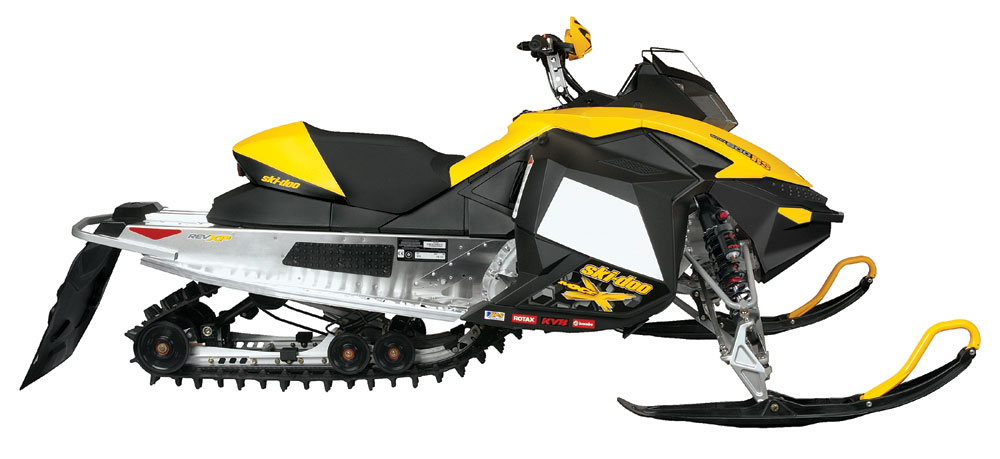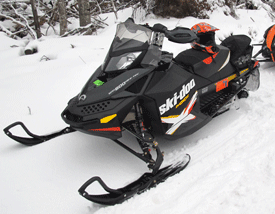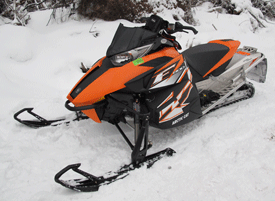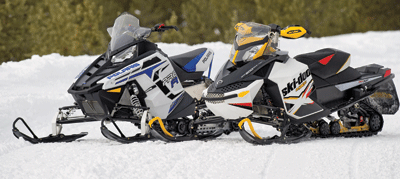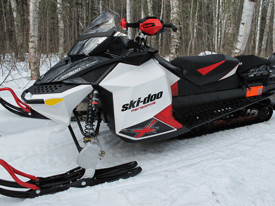Test Ride: 2012 Ski-Doo MX Z X
March 22, 2011
I just returned from a snowmobile trip to Grand Marais, Minnesota, where I spent more time getting to know Ski-Doo’s new rMotion rear suspension. The main reason for my trip was to log more miles on some of our demo sleds and test some of the aftermarket parts for stories that we’ll publish in Snow Goermagazine next fall, but Ski-Doo made the 2012 MX Z E-TEC 800R X available to us after it was run through the ringer at Snow Shoot, an annual snowmobile media event that we attended earlier this month in West Yellowstone, Montana, to test ride and photograph the 2012 models from Arctic Cat, Polaris, Ski-Doo and Yamaha.

Was this my last ride of the season? Maybe, but trail conditions in the far-northeastern reaches of Minnesota were excellent — like, mid-January excellent — so something tells me I’ll be able to escape to there again this spring. (Although, paying up to $4.65 for a gallon of premium fuel makes it an awfully expensive endeavor!)

In case you’re not familiar, the rMotion rear suspension was announced in February and will be in all 2012 Ski-Doo MX Z X and X-RS sleds. It’s a progressive-rate suspension, meaning it gets progressively more resistant to compression as it’s squeezed farther into its suspension travel. For the record, Ski-Doo lists travel at 15.5 inches.
The rMotion suspension was designed to offer easy adjustability, including tool-less adjustable coupler blocks that control weight transfer — earlier Ski-Doo skidframes and versions from other snowmobile manufacturers require a few hand tools and about 15 minutes to adjust. Add the optional Quick Adjust system to the rMotion and adjusting torsion spring preload is as simple as turning a running board-mounted dial. The rear shock’s compression clicker adjuster is mounted on the other side of the running board. The rear shock can be bolted into one of two positions, depending upon the rider’s preference. The stock, lower mount point is the “high-performance” setting; the upper hole is “sport,” generally reserved for riders looking for softer suspension action.
Before hitting the trail this weekend, I adjusted the shocks’ clickers to settings that have performed well for me on other Ski-Doo X package sleds I’ve ridden in the past — ski shocks: 5 clicks from full soft; rear shock: 5 clicks from full soft; center shock did not have a clicker. The new rMotion rear suspension’s rear shock was bolted in the performance setting and the rear coupler blocks were set to provide maximum weight transfer. More weight transfer generally translates to more traction and a cushier ride.
We rode a fabulous State of Minnesota-maintained trail that enables riders to carry fast speeds while still challenging their riding abilities; there’s a lot of elevation change and switchbacks with varying levels of “tightness” that dictate how fast riders can carve through the dense hardwood and softwood trees that line the trail.
Wheelie-ing over a few rises in the trail and generally experiencing too much inside ski lift when accelerating out of corners prompted me to pull over and adjust the coupler blocks just a few miles into our ride. I moved the blocks from “1” to “2,” and that setting proved to work well for me and for a buddy who also rode the sled and weighs about 30 pounds more than my 155 pounds. The adjustment took 10 seconds, which left me with another 20 seconds to spare while I waited for the last rider in our group to catch up before we turned at an intersection. The next 20 miles of our ride was mostly smooth with nary a bump to cycle the shocks and suspension, but I was able to get a good feel for how well the sled handles.

“Precise” is the best word to describe how this MX Z handled. Ski lift was minimal and the keels carved comfortably through the wet, late-season snow. As the miles clicked off and I got more familiar with the feel of the sled, I became more confident in the machine and was able to push harder; driving deep into the corners, crawling forward on the console and leaning out to help keep the inside ski down. Steering effort was light.
Farther down the trail, many corners had choppy bumps — ranging from about 8 inches to more than a foot deep — at their entrance and exit. Since I felt too much feedback through the front suspension when driving aggressively into these corners, I adjusted the front shock compression clickers to three clicks from full soft. I wasn’t bottoming the front suspension and the front end felt too harsh, which is why I set the shocks to a softer setting.
The rMotion rear suspension worked very well. It let me run over the chatter without lifting my thumb off the throttle lever. The sled tracked through the bumps without pitching, diving or kicking off of the line that I had set. Performance when powering through big “G” bumps — the deep hole that forms before a rise in the trail that often goes unnoticed before it’s too late and zings the spine — probably would have stung me if I’d have been on just about any other rear suspension. Despite the fact that the rMotion was working well, I turned the rear shock’s clicker one notch toward full soft for good measure and to see if I could make the rear suspension even more comfortable.
After making the adjustments, the sled was more comfortable. The softer settings allowed the shocks to absorb the bump rather than resist compression and make the suspension feel too firm. Trail chatter is where the rMotion rear suspension shines. It’s engineered to allow the suspension springs to absorb those little bumps that are close together and rattle the teeth, and then rely more on the shocks as bumps get bigger and vehicle speed increases.
I’ve been impressed with the rMotion rear suspension since I first rode it at Ski-Doo’s test facility in Quebec, Canada, in late January. There, the bumps were harder than what I rode a few days ago. I noted during that trip that the rear suspension worked so well that it might cause sledders to over-ride the REV-XP dual A-arm front suspension. After riding other rMotion-equipped sleds, I haven’t had those same thoughts.

Did the sleds that I rode in Quebec have better shock calibrations? Or maybe I’ve just gotten used to how the front and rear suspensions work together? It could be that Ski-Doo’s suspension engineers had the Quebec sleds dialed in perfectly for those conditions, whereas rMotion machines I’ve ridden since then might have had the production shock valving and spring calibration that suits a wider range of riders and conditions.
So now I’ve ridden the rMotion rear suspension in three locations; each with different conditions, but every time I’ve come away from the ride impressed with how well the skidframe works. Most importantly, it makes snowmobiling more comfortable so it can be more fun, and its capability to mow down the bumps lets snowmobilers ride harder and faster. Toss in the suspension’s adjustability and, therein adaptability to different conditions, and the rMotion is an excellent suspension that represents another chapter in the progress of snowmobile engineering.
— Andy Swanson, Snow Goer managing editor

